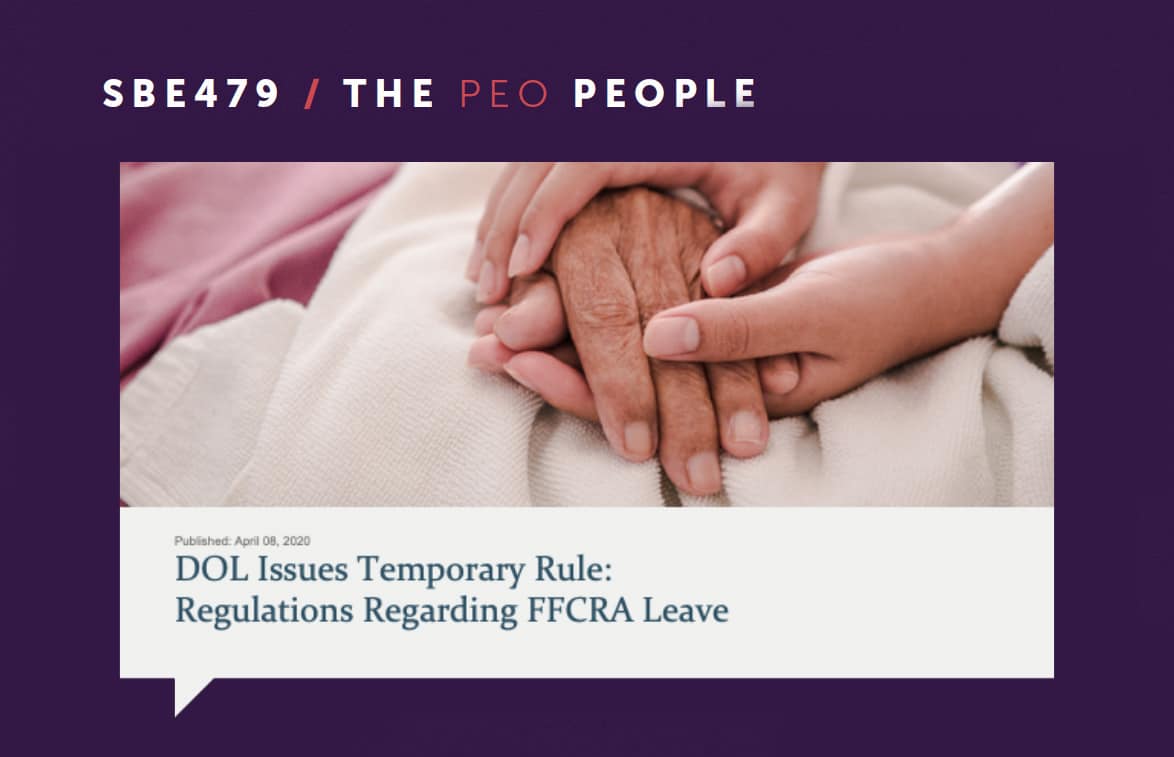
DOL Issues Temporary Rule: Regulations Regarding FFCRA Leave
The Department of Labor (“DOL”) issued temporary regulations to implement emergency paid leave under the Families First Coronavirus Response Act (“FFCRA”), as well as additional FAQs that provide much-needed clarification on many aspects of the new requirements. Below you will find highlights of the new guidance.
Background
Effective April 1, 2020, and ending on December 31, 2020, private employers with under 500 employees (and public employers) are required to provide two new types of leave to employees under the FFCRA. Please review our previous Bulletins for in depth information on these types of leave.
Emergency
Paid Sick Leave
Under the Emergency Paid Sick Leave Act (“EPSLA”), employers must provide two weeks (up to 80 hours) of paid sick leave (at full pay up to $511 per day per employee) where the employee is unable to work or telework because the employee is quarantined by a federal, state or local government order or provider, or the employee experiences COVID-19 symptoms and is seeking a medical diagnosis. Employers must provide two weeks (up to 80 hours) of paid sick leave (at 2/3 employee’s regular rate of pay up to $200 per day per employee) where the employee is unable to work or telework because the employee is (1) caring for an individual subject to a federal, state or local quarantine order or provider order, (2) caring for a child under 18 whose school or child care provider is closed/ unavailable due to COVID-19, and/or (3) experiencing a substantially similar condition specified by the Secretaries of the HHS, Treasury and Labor Departments (none have been identified to date by the Departments).
Expanded FMLA Leave
How long is FMLA? Who has FMLA eligibility? Under the Emergency Family and Medical Leave Expansion Act (“EFMLEA”), employers must provide up to 12 weeks of expanded family and medical leave (after the first two weeks, up to 10 weeks must be paid at 2/3 pay up to $200 per day per employee) to employees employed at least 30 calendar days who are unable to work or telework because they are caring for their son/daughter whose school or child care provider is unavailable due to COVID-19. During the first two weeks of unpaid leave, employees may use paid sick leave under the EPSLA, as described above.
Certain small businesses (under 50 employees) are eligible
for relief if providing these paid
leaves would jeopardize the business’
viability.
Payroll tax credits are available to private employers for all qualifying paid wages and allocable
costs related to the maintenance of health coverage under any group health plan
while the employee is on the leave.
How
Much Time of the EFMLEA is Unpaid?
The regulations clarify that the first two weeks (rather than 10 days as indicated in the FFCRA) of EFMLEA
is unpaid, though an employee may substitute paid sick leave under EPSLA or
other employer paid leave policy during this time.
EPSLA and EFMLEA should work together to permit the
employee to have a continuous income
stream while taking FFCRA leaves.
Is a
Quarantine/Isolation Order the Same as Stay-at-Home or Shelter-at-Home?
A quarantine or isolation order incorporates a broad range of governmental orders, including
orders that advise some or all citizens
to shelter-in-place, stay-at-home, quarantine or otherwise restrict their own mobility.
The regulations clarify that paid sick leave is only available if being subject to one of these orders prevents the employee from working or teleworking. The threshold question is whether the employee would be able to work or telework “but for” being required to comply with a quarantine or isolation order. It should also be noted that an employee will not be eligible for paid sick leave in the case where the employee is self-quarantining due to COVID-19 type symptoms but is not seeking a medical diagnosis or advice of a health care provider.
Who is an “Individual” that may be taken care of in connection with EPSLA?
For purposes of sick leave related to caring for an individual subject to quarantine, the individual being cared for must be an immediate family member, roommate, or similar person with whom the employee has a relationship that creates an expectation that the employee would care for the person if he or she self-quarantined or was quarantined. The individual must be unable to care for him or herself due to a diagnosis of COVID-19 (or is particularly vulnerable to COVID-19) and depends on the employee for care, and providing such care prevents the employee from working or teleworking.
Who is Considered a “Child” and What is Considered a “Child Care Provider” under the
FFCRA?
Under part of the EPSLA and the EFMLEA, an employee may take paid sick leave only when the employee needs to, and actually is, caring for his or her child. This leave is not generally necessary if another suitable individual such as a co-parent, co-guardian or the usual childcare provider is available to provide the care the employee’s child needs. An employee’s child can be over the age of 18 if the child has a disability and cannot care for him or herself due to the disability, provided that the child’s school or place of care is closed, or childcare provider is unavailable due to COVID-19 reasons.
The
DOL’s FAQs also provide the following definitions:
Place of Care: A place of care is a physical location in which care is provided for your child. The physical location doesn’t have to be solely dedicated to such care and includes, for example, day care facilities, preschools, before and after school care programs, schools, homes, summer camps, summer enrichment programs and respite care programs.Child Care Provider: A childcare provider is someone who cares for your child and includes individuals who are paid to provide childcare, such as nannies, au pairs, and babysitters. In addition, it also includes individuals who provide care at no cost and without a license on a regular basis, such as grandparents, aunts, uncles or neighbors.
What
Happens to an Employee’s Health Care Coverage When on an FFCRA Leave?
An employee who takes an FFCRA leave is entitled to continue coverage under the employer’s group health plan on the same terms as if the employee did not take the leave. This includes medical care, surgical care, hospital care, dental care, eye care, mental health counseling, substance abuse treatment and other benefit coverage. If an employer provides a new health plan or benefit package option, or changes health benefits while an employee is taking paid sick leave or expanded family and medical leave, the employee is entitled to the new or changed plan/benefits to the same extent as if the employee was not on leave. Employer must give employees notice of any opportunity to change plans or benefits and if the employee requests the changed coverage, it must be provided by the employer.
Employees on FFCRA leave remain responsible for paying the same portion of the plan premium that the employee paid prior to taking the leave. The employee’s share of premiums must be paid by the method normally used during any paid leave; in many cases, this will be through a payroll deduction.
For unpaid leave, or where pay is insufficient to cover
the employee’s premiums, the rules under traditional FMLA provide mechanisms
for the employer to obtain payment (prepay, pay-as-you-go or catch-up).
If an employee chooses not to retain group health plan
coverage while taking paid sick leave or expanded family and medical leave, the
employee is entitled upon returning from leave to be reinstated on the same
terms as prior to taking the leave, including family member coverage.
What if an Employee is Already Receiving Benefits or Already on Leave?
An employee is typically not eligible to receive paid
leave under the EPSLA or the EFMLEA if receiving workers’ compensation or
temporary disability benefits. However, if the employee was able to return to
light duty, but a qualifying reason prevents the employee from working, then
the employee may be eligible for paid leave.
Whether an employee is eligible for paid leave under the EPSLA or the EFMLEA depends upon whether the employee is on a voluntary or mandatory leave of absence. If it is a voluntary leave of absence, the employee may qualify for paid leave by ending the leave of absence and taking the paid leave (assuming there is a qualifying reason). However, if the employee is on a mandatory leave of absence (e.g., furlough), the employee would not be eligible for paid leave (although the employee may be eligible for unemployment insurance benefits).
How
Long Must an Employer Retain Records?
An employer is required to keep records of employee
documentation and substantiation for four years.
Do
Employees Have to Be Restored to Their Job After the Leave?
Generally, an employee is entitled to
be restored the same or an equivalent position upon return from paid
sick leave or expanded family and medical leave in the same manner that an
employee would be returned to work after FMLA
leave. However, employees subject to
employment actions, such as layoffs, that
would have affected the employee regardless of whether the leave was taken may not be protected. Employers must be
able to demonstrate the employee
would have been laid off even if s/he had not taken leave. For
leave taken under the EFMLEA, an employer may deny restoration to key eligible employees (as defined under
the FMLA), if such denial is necessary to prevent
substantial and grievous economic injury to the employer’s operations.
The job restoration provision does not apply to employers
with less than 25 employees if:
- The employee took leave to care for his
or her son or daughter whose school or place of care was closed or whose child care provider was unavailable;
- The employee’s
position no longer exists due to economic or operating conditions that
(i) affect employment and (ii) are
caused by a public health emergency (i.e., due to COVID-19 related reasons) during
the period of the employee’s leave;
- The employer made reasonable efforts to restore the employee to the same or an equivalent position; and
- If the employer’s reasonable efforts to restore the employee fail, the employer makes reasonable efforts for a period of time to contact the employee if an equivalent position becomes available. The period of time is specified to be one-year beginning either on the date the leave related to COVID-19 reasons concludes or the date twelve weeks after the employee’s leave began, whichever is earlier.
We will continue to monitor developments and provide you
with updates.


